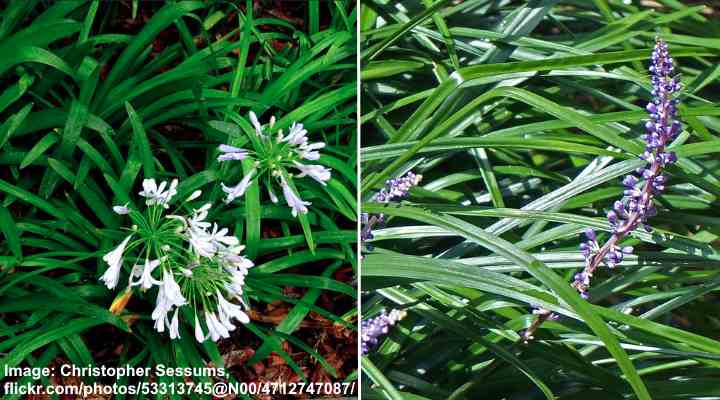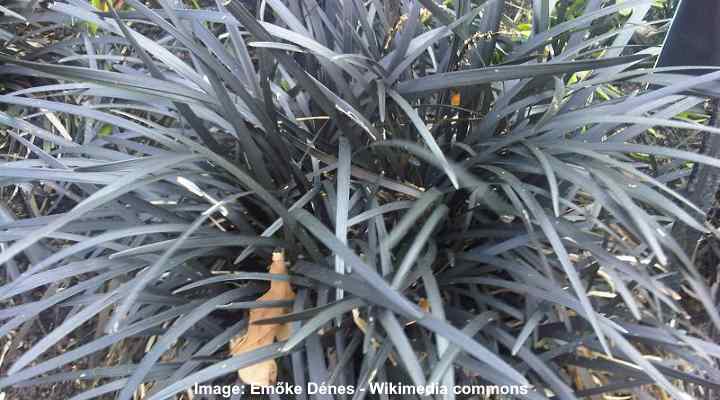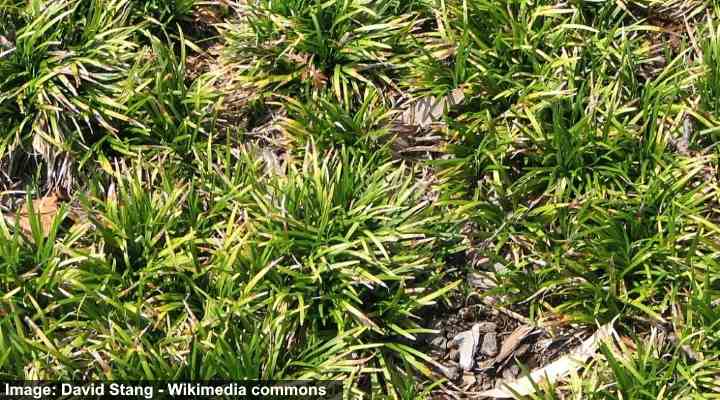Mondo grass (Ophiopogon) is a versatile, low-growing leafy plant that can be used to replace turfgrass. Mondo grass is low-maintenance, grows in the shade, does not take over gardens, and lasts all year. It is therefore a good option for landscaping.
Black mondo grass, dwarf mondo grass, and variegated mondo grass are some of the other types of mondo grass available. Any kind of mondo grass is ideal if you’re looking for evergreen ground cover for shade or sun. This is a comprehensive guide to growing and caring for mondo grass. From planting mondo grass seeds to ensuring that the perennial plant thrives throughout the year, you’ll learn helpful tips.
Information About Mondo Grass
Mondo grass is a decorative flowering plant with long, spiky strands of grass that looks like tufts. Mondo grass is classified as part of the Ophiopogon genus and the Asparagales family. The family Poaceae includes genuine turfgrass, such as that used in lawns.
Mondo grass doesn’t need to be mowed, unlike lawn grass. Between 8″ and 15″ (20 – 40 cm) long, mondo grass has thin green blades. From tuberous roots that spread slowly beneath the ground, a thick, tough ground cover is created by the leafy plant growing in clumps. Mondo grass tufts grow to a height of around 12 inches (30 cm) on average.
Mondo grass (raceme) bears clusters of delicate lilac-colored blooms on a spikey stem. Most mondo grasses, including Ophiopogon japonicus and Ophiopogon planiscapus ‘Nigrescens’, are slow-growing plants. Ophiopogon japonicus ‘Nana’ is a well-known slow-growing and slowly spreading dwarf mondo grass cultivar.
Where to plant mondo grass
Mondo grass is a versatile garden landscaping plant that grows in full sun to complete shade. Plant mondo grass in well-draining soil to grow these dense tufts of strappy leaves. The appealing clumps develop in most soil types, from clay to loamy sandy soil, because this grass-like plant is adaptable.
Plant the conventional types 4″ to 12″ (10 to 30 cm) apart to produce mondo grass in your garden. The denser ground cover you’ll get by planting your clumping plants closer together. Leave between 2″ and 4″ (5 – 10 cm) between the tufts if you want to grow dwarf mondo grass.
In mixed beds, along borders, perennial edging, planting beneath shrubs, or adding greenery to gravel gardens, mondo grass is also excellent for evergreen ground cover. Walking on mondo grass, both the ordinary and dwarf types, is acceptable on occasion.
The strappy blades, on the other hand, will be destroyed by frequent foot traffic before they have a chance to grow. Place stepping stones through the mondo grass area when planting mondo grass in a garden landscape.
Mondo Grass Vs. Monkey Grass

Mondo grass is easy to mistook for a similar-looking plant known as monkey grass or lilyturf. Lilyturf (Liriope) is a clumping plant with arching grass-like blades that looks similar to mondo grass. Monkey grass, creeping liriope, and spider grass are popular names for lilyturf plants. Nonetheless, lilyturf (Liriope) varieties are the only ones called monkey grass by some individuals.
Mondo grass (Ophiopogon japonicus) is seen on the left. Lilyturf (Liriope) is a kind of grass that is commonly known as monkey grass.
How to Care for Mondo Grass – Overview
Plant mondo grass (Ophiopogon japonicus) in well-drained soil to care for it. Mondo grass thrives in full sun, partial shade, or full shade and is a simple-care garden plant. During hot weather, water the grassy clusters on occasion. You may fertilize mondo grass with diluted lawn fertilizer every spring, even if it is not necessary.
Types of Mondo Grass (With Pictures)
Green mondo grass (Ophiopogon japonicus), black mondo grass (Ophiopogon planiscapus ‘Nigrescens’), and variegated mondo grass (Ophiopogon jaburan ‘Vittatus’) are the three main varieties of mondo grass. Mondo grasses are available in a variety of cultivars, and dwarf mondo grass (Ophiopogon japonicus ‘Nana’) is one of the most popular. Let’s explore the many forms of mondo grass and how to grow them, as well as some helpful tips for maintaining them.
Mondo Grass (Ophiopogon japonicus)

Mondo grass (Ophiopogon japonicus) is a tiny-growing foliage plant with thin, long green blades that grows in both bright and shaded regions. This hardy grass-like ground cover has tight, dense growth and can be used as a ground cover. Throughout the year, the evergreen perennial landscaping plant assists maintain a carpet of greenery in gardens.
Mondo grass has several benefits over lawn turf due to its evergreen growth. Mondo grass thrives in shaded areas, unlike turfgrass, which requires sun or partial shade to grow.
This permits you to use mondo grass as a long-term shade ground cover for shrubs, trees, or other sections of your garden. Mondo grass grows up to 2 feet (0.6 meters) wide and grows between 10 and 14 inches (25 and 35 centimeters) tall. Mondo grass is suited for eliminating weeds due to its deep growth habit and robust root system.
Despite the fact that you can walk on mondo grass, it’s not a suitable grass for serious pedestrian traffic. Mondo grass is a summer flowering plant with little purple-lilac blossom clusters that appear. After blooming, the blossoms turn into little blueberry-like fruits that are appealing.

Fruits of Mondo grass (Ophiopogon japonicus)
How to plant mondo grass
Mondo grass prefers well-drained soil. Dig in 2″ or 3″ (5-7.5 cm) of compost around the roots of small plants being grown in pots. Plant at the same height as it was in the pot, making a hole large enough for the roots. Depending on your desired density, plant mondo grass tufts between 4″ and 12″ (10-30 cm) apart. Mondo grass should be kept in a medium wet environment where it is planted.
Mondo grass thrives in most soil types, grows in the sun or the shade, and withstands some drought because it is so adaptable. USDA zones 7 through 10 are ideal for mondo grass. As an edging plant, under-planting shrubs, or creating gravel gardens more appealing, ornamental mondo grass plants should be cultivated in the ideal locations.
How to care for mondo grass
To thrive, mondo grass requires very little upkeep. Once the plant is established, you’ll have to keep the soil moist. Water mondo grass was maintained throughout the summer to keep the ground wet. To keep it tidier, all you have to do after it is established is cut back the thin leafy foliage every other year.
How to propagate mondo grass
The most effective method to spread mondo grass is through root division. To remove clumps of mondo grass from the ground, use a garden fork. Using a sharp knife or shovel, separate the tufts into two. In your garden landscape, replace the mondo grass tufts where you need attractive grasses.
The thick ground cover growth may need to be thinned out every three years. In the spring, you should take root cuttings for the best results when propagating mondo grass.
How to grow mondo grass from seeds
It’s difficult to grow mondo grass from seeds. Soak seeds for two days in a bowl of water, either fresh or dried. Plant the seeds in a 1″ (2.5 cm) layer of sterile potting soil, then lightly cover them with soil. Mist the soil, place it in a plastic bag in a shady area, and seal it. Planting mondo grass seeds in November is the optimum time. The seeds should germinate by May if you keep the soil moist.
Mondo grass berries are good to harvest seeds from around the end of October, and they’re available at your local garden shop. You can put new mondo grass plants into your garden when the weather warms in the spring.
Black Mondo Grass (Ophiopogon planiscapus ‘Nigrescens’)

Black mondo grass is a dramatic landscape foliage plant with thin black arching blades that adds interest to gardens all year. Black mondo grass grows to be between 6 and 8 inches (15 and 20 cm) tall, also known as “Black Dragon” or “Ebony Night.” Pinkish-white blooms and dark purple berries characterize black mondo grass.
For adding drama to your garden, black mondo grass is an excellent choice. The dense black ground cover is created by spreading out the black grass-like blades, which are 8″ to 12″ (20 – 30 cm) long. This black variety, like other mondo grass varieties, is an evergreen tough garden plant that thrives in sun or shade.
How to plant black mondo grass
In full sun to partial shade, grow black mondo grass. In well-draining, rich soil that contains some moisture, grow this black ‘grass. So that its roots can establish before winter, black mondo grass is best planted in the spring. Add a stunning jet-black accent to gravel gardens by planting black mondo plants under shrubs, along the borders, in mixed beds.
How to care for black mondo grass
During the growing season, water black mondo grass once a week. The black variety needs more water than regular mondo grass. You should water the plant frequently enough to ensure that the ground is moist and that the roots are never “standing” in soggy soil. In the winter, watering the black grass-like plant is not necessary.
How to propagate black mondo grass
In the spring, splitting the rhizome roots is the best way to propagate black mondo grass. To remove the plant tufts from the ground, use a garden fork. Then use your hands or a sharp knife to separate the clumps into two sections. Between 4″ and 12″ (10 cm) apart, replant the ground cover plants.
Until the roots are developed, keep the soil moist. It takes a long time for black mondo grass to grow. As a result, establishing a broad area of ground cover through propagation is occasionally the quickest route.
Dwarf Mondo Grass (Ophiopogon japonicus ‘Nana’)

Dwarf mondo grass is an ideal plant for filling between stones or pavement in the garden, with short leaves. This small mondo grass cultivar stands just 3 to 6 inches (7 to 15 cm) tall and has a comparable spread. Little, thin spikey-looking dark green grass blades characterize dwarf mondo grass. Little white flowers and blue berries bloom on this evergreen landscape landscaping ground cover.
Turfgrass lawns that require little mowing or care may use dwarf mondo grass as a perfect alternative. The ‘Nana’ cultivar is more robust and able to withstand moderate foot traffic when compared to other mondo grass varieties. Dwarf mondo grass may be used as edging, ground cover, borders, or shade-tolerant plants in addition to a lawn substitute.
In addition, spreading dwarf mondo grass may be used to conceal exposed ground beneath bushes or trees. Mondo grass, a dwarf creeping plant, is ideal for growing between stones or pavement in yards. Ophiopogon japonicus ‘Nana’ is the slowest-growing of all the mondo grass varieties.
Dwarf mondo grass care
Water the tufts of blades sufficiently in the spring and summer to keep the soil wet for dwarf mondo grass care. Mini mondo grass thrives in damp soil that retains some water. Full sun tolerance is common with dwarf mondo grass, which thrives in partial shade.
To prevent the roots from rotting, do not water during the winter. Mow the grass once a year in early spring or late winter to care for dwarf mondo grass as a lawn grass alternative. Set the mower’s highest height settings to prevent plant damage. The dwarf cultivar, like all types of mondo grass, is drought tolerant as well.
Dwarf mondo grass propagation
Divide the clumps of blades to spread dwarf mondo grass. Cut the little plant into two or three pieces and dig up some well-established dwarf mondo tufts. Whenever you need evergreen ground cover in your yard, plant the separated plants 2″ and 4″ (5 – 10 cm) apart.
Growing dwarf mondo grass from seeds
Harvest seeds from the berries in late October or early November to start growing dwarf mondo grass. Soak in warm water for two days in a bowl.
Then, in sterile potting soil, plant the mondo grass seeds about 0.4” (1 cm) deep. Mist the ground, cover it with a plastic bag, and store it in a chilly, dark corner. Keep the soil moist at all times. In the next spring, your new plants should be ready to be planted in your garden.
Variegated Mondo Grass (Ophiopogon jaburan ‘Vittatus’)

Variegated mondo grass has yellow and green variegation on the leaves, which arch ribbons. The striped leaves on the thick grass-like tufting grow between 12 and 24 inches (30 and 60 cm) tall. Variegated mondo grass grows as an evergreen spreading perennial and creates a leafy carpet in shady or sunny landscapes.
Variegated mondo grass is commonly referred to as monkey grass due to its resemblance to lilyturf. The genus Liriope does not include this species, Ophiopogon jaburan.
Where other ground cover plants don’t grow, grow variegated mondo grass as a shade ground cover. Edging, under-planting shrubs, border plants, and rock gardens are all ideal habitats for this species of Ophiopogon. Brightening up any garden landscape with its vivid yellow and light green foliage colors is easy.
Diseases and Pests Affecting Mondo Grass
The most prevalent garden pests affecting mondo grass are slugs and snails. After rainfall, snails and slugs are frequently seen crawling through the grassy blades. wilting leaves and chewed blades are indicators that mondo grass growth is being affected by pests. You should manually remove all snails and slugs after any rain, or use organic slug killer pellets that include iron phosphate as an active ingredient to do so.
Mondo grass growth is most frequently affected by root rot. When the earth is excessively wet or waterlogged, roots begin to rot. The dark green grass blades can quickly turn yellow or brown if the rhizome roots begin to decay. It’s essential to refrain from watering until the top layer of soil is dry if you detect any indications of root rot.
You’ll need to improve drainage if the mondo grass is growing in a garden area where water tends to pool. Compost must be added to the soil in order to help mondo grass thrive.
